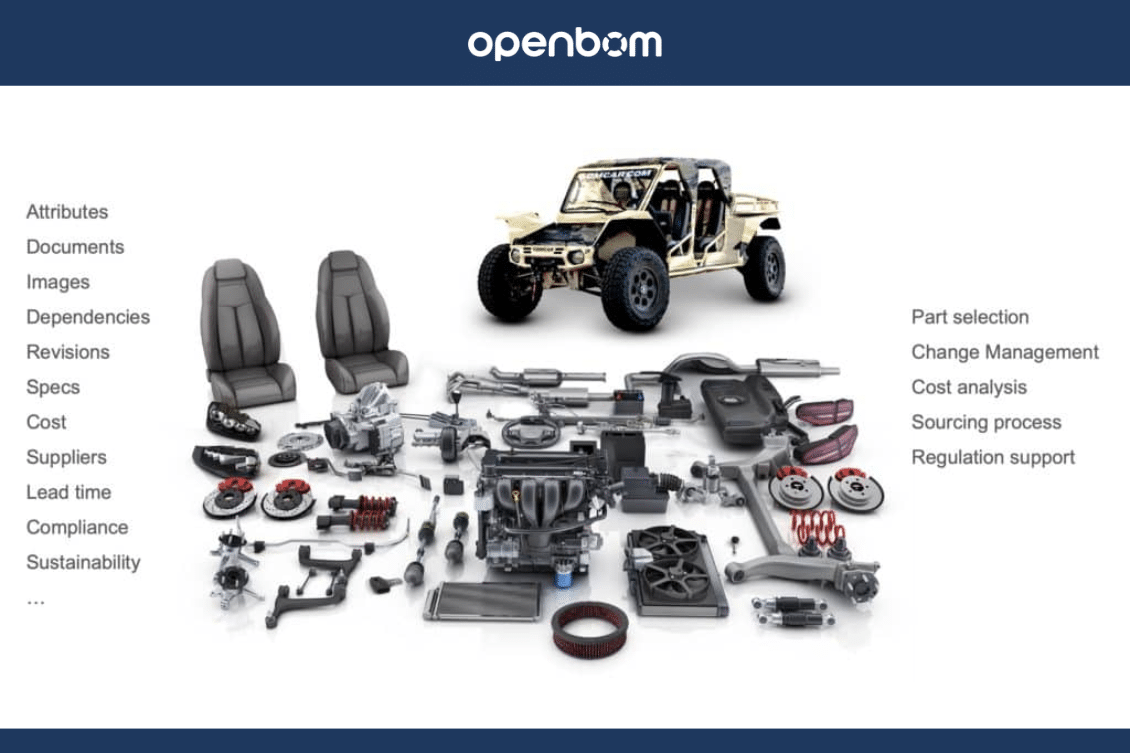
Managing data is becoming a super-critical element of modern product development. Engineering teams and manufacturing companies need to manage three levels of complexity: product complexity, process complexity, and organizational complexity. The complexity of the product is driven by multi-disciplinary design (mechanical, electronics, software). Process complexity arises from the need to coordinate operations and change processes between multiple teams. Finally, organizational complexity is driven by the fact that people involved in modern product development often belong to multiple organizations. What technical capabilities of OpenBOM can help engineering teams cope with multi-dimensional complexity levels? Let’s explore this in detail.
1. Flexible Data Modeling Architecture
OpenBOM’s flexible data modeling architecture allows teams to build any type of object with any attribute, representing all aspects of product complexity. Data that needs to represent different systems (mechanical, electrical, software) can be combined in a flexible yet simple way. This capability ensures that all elements of a product, regardless of their nature, can be integrated and managed cohesively.
Read more about OpenBOM’s flexible data model, management of multi-disciplinary data structures, and data properties.
2. Multi-Tenant Data Management and Cloud Architecture
The multi-tenant data management and cloud architecture of OpenBOM allows multiple organizations and teams to share data seamlessly without the need to export, copy, or import data. This feature is particularly crucial for managing organizational complexity, as it enables different entities involved in product development to collaborate efficiently, ensuring that all stakeholders have access to the latest information.
3. Seamless Integrations with CAD Systems
OpenBOM offers seamless out-of-the-box integrations with both cloud and desktop CAD systems. This capability automates the process of data extraction for product structures, CAD files, and derivative file formats. By integrating directly with CAD systems, OpenBOM eliminates the manual and error-prone process of data transfer, ensuring that the product design data is always up-to-date and accurately reflects the current state of development.
Read more about designing digital thread and OpenBOM CAD integrations.
4. Instant Collaboration and Simultaneous Editing
OpenBOM supports instant collaboration and simultaneous editing, allowing data engineers to work on the same data collaboratively without the need to lock data for individual use. This feature enhances process efficiency by enabling real-time updates and reducing the time spent on coordinating changes. Teams can work together more effectively, ensuring that all modifications are captured immediately and that everyone is on the same page.
Read more about it in this article.
5. Comprehensive NPD Support
Out of the box, OpenBOM provides comprehensive support for New Product Development (NPD), from design file management to multi-view product structures, ordering, purchase orders (PO), and requests for quotations (RFQ). This end-to-end support streamlines the entire product development process, ensuring that all aspects, from initial design to final procurement, are managed within a single platform. This capability not only simplifies the management of product and process complexity but also ensures that all data related to NPD is consistent and easily accessible.
Conclusion
OpenBOM’s unique data management architecture, combined with its collaborative capabilities, seamless integrations, and connected NPD processes, provides engineering teams and manufacturing companies with the tools needed to accelerate product development. By managing multi-dimensional complexity effectively, OpenBOM helps organizations build better products faster and with greater accuracy, ultimately enhancing their competitive edge in the market.
REGISTER FOR FREE to check how OpenBOM can help you.
Best, Oleg
Join our newsletter to receive a weekly portion of news, articles, and tips about OpenBOM and our community.










